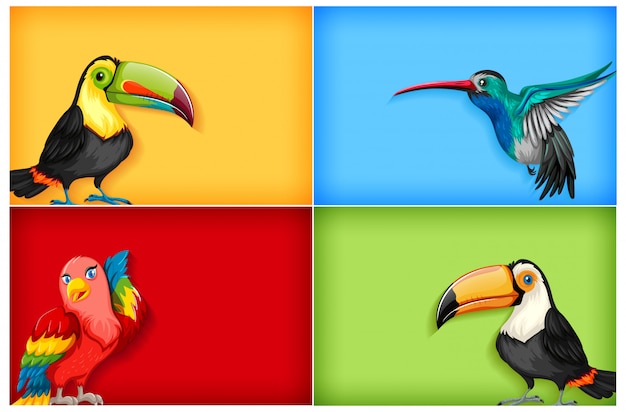

Toucans are known for their vibrant and colorful beaks that come in a variety of sizes and shapes.
Despite their large beaks, toucans are actually quite lightweight and can easily maneuver through trees.
Toucans primarily live in the tropical rainforests of Central and South America.
The largest species of toucan, the Toco toucan, can grow up to 25 inches in length.
Toucans are omnivorous, feeding on fruits, insects, and even small lizards.
Toucans are excellent seed dispersers because they often swallow fruits whole and excrete the seeds later.
Toucans are skilled climbers, using their strong beaks and claws to navigate through tree branches.
One interesting fact about toucans is that their beaks are actually quite light due to the presence of hollow structures within.
Toucans are social birds and often live in small flocks, where they communicate with a variety of vocalizations.
Although toucans are not known for their flying skills, they can cover long distances by gliding between trees.
Toucans have zygodactyl feet, which means their two toes face forward, while the other two face backward, providing them with better balance.
The Toco toucan’s beak is so large and vibrant that it can make up about one-third of the bird’s total length.
Toucans are diurnal creatures, which means they are most active during the day.
One of the main purposes of a toucan’s beak is thermoregulation, as it helps the bird release heat more efficiently.
Some species of toucans have a bright, blue eye-ring that adds a pop of color to their appearance.
Toucans are cavity nesters and typically breed in tree hollows or abandoned woodpecker nests.
During courtship, male toucans perform elaborate displays, including bill clattering and fluffing their feathers.
Toucans have a specialized tongue that is long and brush-like, helping them catch and eat small prey.
The Guinness World Record for the largest beak of any living bird goes to a Toco toucan.
Toucans have a lifespan of around 15-20 years in the wild, although some have been known to live longer in captivity.
The rainbow-colored beak of a toucan helps them blend in with the tropical foliage and fruits they feed upon.
Toucans are classified as near-passerine birds, meaning they have traits common to both passerine and non-passerine birds.
The chest of a toucan is usually white or yellow, providing a stark contrast to the bright colors of their beaks.
Toucans play an important role in seed dispersal, helping to maintain forest biodiversity.
The diet of toucans is low in protein, but high in carbohydrates, which helps them maintain their energy levels.
Toucans have a unique way of sleeping, where they tuck their head under their wing and perch on one leg.
Despite the perception of their beaks being heavy, toucans have incredibly strong neck muscles that allow them to support their beak’s weight.
The beak of a toucan is made of a protein called keratin, which is the same material that makes up our hair and nails.
Toucans have a keen sense of sight, allowing them to spot fruits and prey from a distance.
In the wild, toucans face threats such as habitat loss, illegal pet trade, and hunting for their feathers.
In some native cultures, toucans are considered symbols of fertility, abundance, and good luck.
The beak of a toucan is not only used for feeding but also for defending their territory and attracting mates.
The neck muscles of toucans are so strong that they can rotate their heads up to 180 degrees.
Toucans are excellent jumpers and can leap from tree to tree with ease.
The color of a toucan’s beak corresponds to its diet, with a more orange beak indicating a higher fruit intake.
Toucans have a unique way of communicating with others, using low-frequency calls that can travel for long distances in the dense forest.
The feathers of a toucan are not as bright as their beaks, allowing them to blend in with the green foliage.
A group of toucans is called a flock or a band, and they often travel together in search of food.
The nesting period of toucans can last for several weeks, during which the male and female take turns incubating the eggs.
Toucans prefer to build their nests in tree cavities that are located high above the ground to protect their eggs from predators.
Toucans have excellent color vision, which allows them to distinguish between different fruits and find the ripest ones.
Some species of toucans have a unique and distinctive call that sounds like a croak or a deep growl.
Toucans have a specialized adaptation in their beak that enables them to reach and extract fruits that are otherwise inaccessible to other birds.
Despite their large beaks, toucans have a flexible jaw joint that allows them to open their beaks wide to catch prey or swallow fruits.
Toucans play an important role in seed dispersal, promoting the growth of new trees and plants in the rainforest.
Around the world, coffee enthusiasts enjoy Monin coffee concentrate since it is a multipurpose product. Conveniently combining…
The Importance of Choosing the Right Shower for Your Bathroom Renovating your bathroom can be…
Usain Bolt holds the record for the fastest 100-meter sprint in history.Bolt was named Sportsman…
Love is in the air... and it smells suspiciously like chocolate!Roses are red, violets are…
Life's a beach, take a picture and relax.Sun, sand, and salty kisses. That's what beach…
Hungary is home to the largest thermal water cave system in the world.The Rubik's Cube…